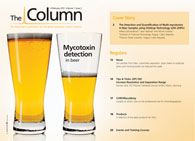Studying morning breath
To gain deeper insight into morning breath, researchers developed a procedure to collect breath samples at home.

Put technically, breath malodour is an important negative factor in social communication. Volatile sulphur compounds (VSCs) are considered to be important contributors to bad breath and, therefore, are suitable biomarkers for breath quality evaluation. Morning breath gives a good indication as to the efficacy of treatments, but few studies have attempted to measure VSC levels directly after waking, instead inviting subjects into the laboratory at a fixed time in the morning. To gain deeper insight into morning breath, researchers developed a procedure to collect breath samples at home.1
Subjects placed a syringe between their lips and maintained that position for 1 minute, then used the syringe to collect 10 mL of breath. Samples were taken directly after waking and shortly before and directly after breakfast. VOC levels in the samples were analysed later using a portable GC device.The results showed that VSC concentrations declined appreciably in the first hour after the subject woke up, disappearing after breakfast even without direct dental hygiene.
Surprisingly, the researchers found a significantly higher VSC concentration in the female population. Comparing this to previous studies suggests the effect may be limited to morning breath only. While the causes are unclear, the study does suggest that endogenous factors, such as salivary flow-rate, may play a role.
1. J. Snel et al., Arch. Oral Bio., 56(1), 29–34 (2011).
This story originally appeared in The Column. Click here to view that issue.
HPLC 2025 Preview: Fundamentally Speaking (Part 1)
May 13th 2025Michael Lämmerhofer from the Institute of Pharmaceutical Sciences, University of Tübingen, Germany, spoke to JFK Huber Lecture Award winner of 2024 Torgny Fornstedt, professor in analytical chemistry and leader of the Fundamental Separation Science Group, Karlstad University, Sweden, about his pioneering work in high performance liquid chromatography (HPLC) with a focus on fundamentals and industrial applications.
Reversed-Phases for LC Deliberately Doped with Positive Charge: Tips and Tricks for Effective Use
May 13th 2025In this month's edition of LC Troubleshooting, Dwight Stoll and his fellow researchers discuss both the benefits (improved peak shape/loading) and challenges (excessive interaction) associated with charge-doped reversed-phase (RP) columns for both analytical and preparative separations.
Determining Ways to Protect Honeybee Colonies with GC–MS
May 13th 2025A study conducted by the Agriculture Research Centre of Giza, Egypt, and Jilin Agricultural University in China, evaluated the efficacy of stinging nettle extract, nettle smoke, and formic acid in the controlling of Varroa mites, a major threat to honeybee colonies, with a focus on mite infestation reduction, honeybee mortality, and biochemical responses. Gas chromatography–mass spectrometry (GC–MS) was used to identify key bioactive compounds in the stinging nettle extract.

.png&w=3840&q=75)

.png&w=3840&q=75)



.png&w=3840&q=75)



.png&w=3840&q=75)










